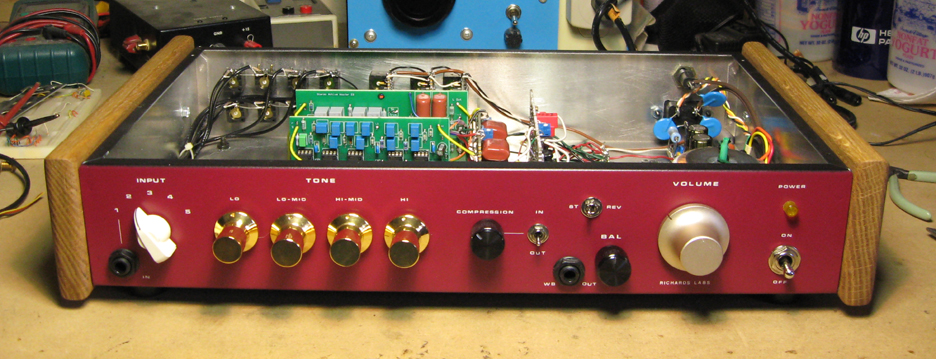
I designed and built these circuit boards for a different project (a surround sound sythesizer) but decided not to build it after all. I guess I decided that a Circle Surround decoder and a Lexicon quad digital reverb would be enough for the kind of surround I want. Then I got inspired to do something with these 8 inch kevlar Focal brand woofers I bought back in the 1990's. They were just sitting in a box taking up space, and too good to throw out. The AR4X speaker from 1964 had appealed to me when I was in gradeschool, and I had some very nice Peerless/Vifa 3 inch TC drivers that I had recently discovered that could do from 300HZ on up pretty darn well, so I decided to crank out yet another pair of speakers (like I don't have enough speakers already). I also had some Peerless cone super tweeters from the McIntosh ML-1 that I loved the sound of sittin in another box waiting for their day in the sun again. I can't leave well enough alone. I always have to complicate my projects as much as I know how. So now these speakers that I call the AR4XC (C for clone, sort of) would be 3 way. I realized that to do it really well, I'd want to bi-amp between the woofers and the 3 inch, 4th order active, and do the upper crossover at 8kHZ one pole passive. Crossover related anomolies at 8kHZ should be much less audible than at 500HZ. Once you've built up a chassis with that much stuff, it's not a lot more work to add active EQ to make the woofer acoustically flat down to 30HZ... That's a huge improvement in my opinion. I absolutely love low bass. Well, I already had the boards built up for that other project that got cancelled, including a tone board which is actually an entire preamp circuit, so I figured that instead of just making an active crossover and woofer EQ chassis, I might as well make a whole preamp, with the biamp outputs as an option. So that's how this project came about. I call it the Tonemeister because it's got my 4 section Basandall circuit, which I consider superior to anything I've seen out there. Just my personal opinion. Other opinions may be fine for other people. This is what I want. I first designed and built this tone control circuit in 1983, and have lived with it since, and have no problem at all with it. Any less is not enough, any more is too much. The "Loudness Compensation" switch on the old preamps from the "Golden Age" were a good concept on paper, but rarely flexible enough to necessarily give you what you want. These tone controls are optimized to give you the exact flexibility you need for that purpose. Listening room acoustics and recording issues are other reasons you need good tone controls.

It's done and works great.
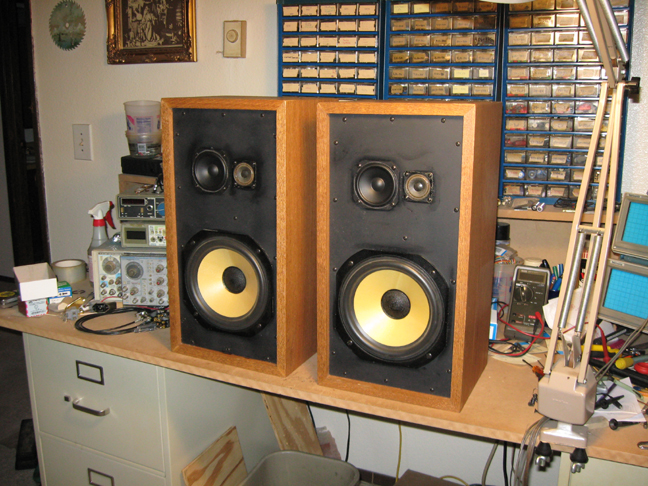
These are the speakers I optimized the active crossover and EQ for. I'll do a separate wrtie up on these when I get the time.
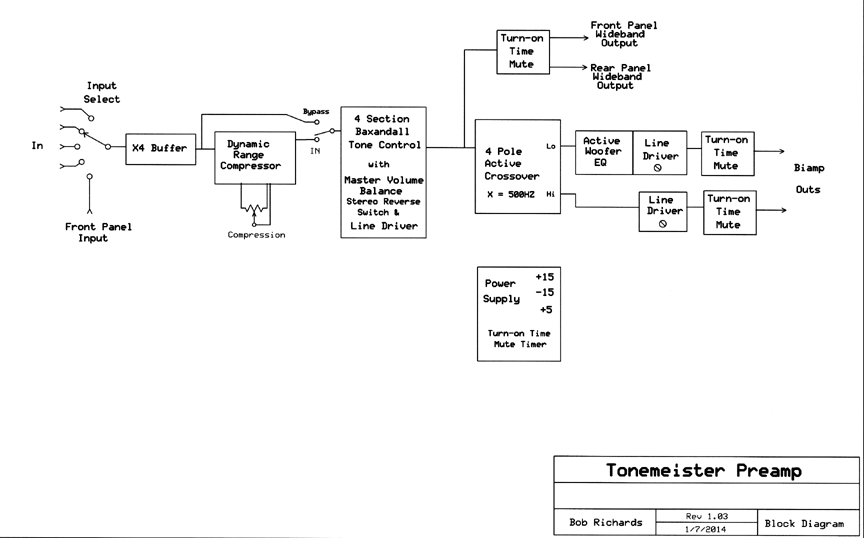
It can be used as a regular preamp with the stereo wideband outputs, and/or with the optional actively equalized, 4th order, bi-amp outputs with X = 500HZ.
In this case, I've optimised the active crossover and EQ for an 8 inch kevlar woofer in a sealed box.
The active EQ should create a fairly flat acoustic frequency response down to 30HZ, and the 4th order cutoff at 500HZ, should keep that 3kHZ resonant peak MANY decibels down (40+ dB).
The 8 inch woofer could have been used up to 1kHZ, but it starts getting directional at that frequency. The 3 inch in it's sub-enclosure is very flat and very clean down to 350HZ. In the interest of a better off axis reasponse, I thought 500HZ would be a good choice.
Both types of outputs can be used simultaneously.
For example, the front speakers could be biamp'd, and the wideband outputs could drive a surround sound decoder and/or digital reverb, which would then drive side or rear speakers.
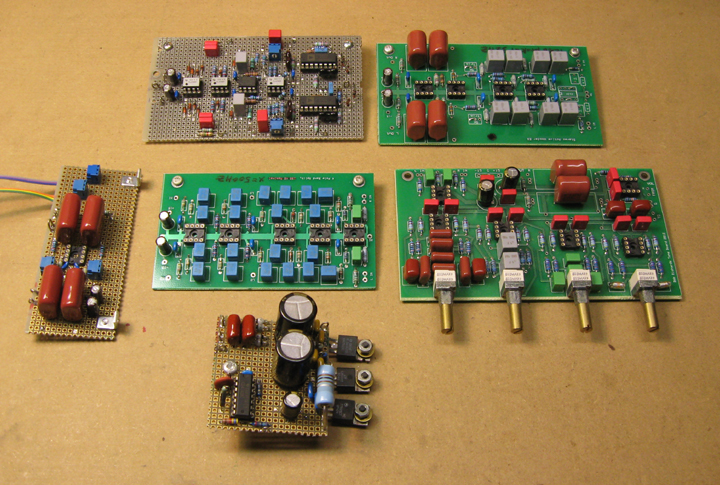
Getting the boards ready.
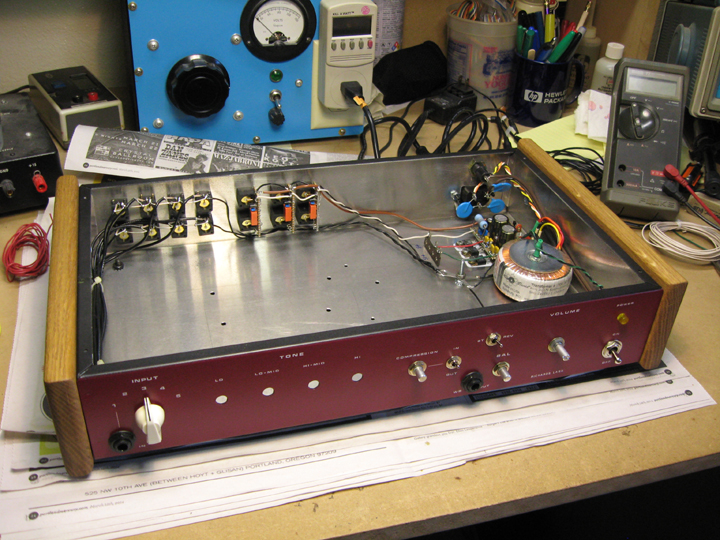
The RCA output jacks all have gold contact sealed relays (the orange things) that disconnect the outputs during turn-on time (3 seconds) or when the power gets interupted (fast reset design).
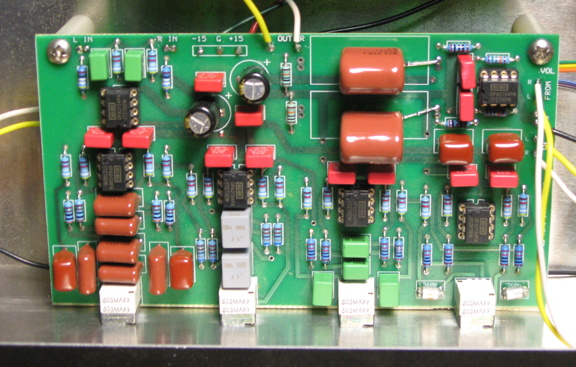
This board has all the tone control circuitry, plus an input buffer with a passive Rf filter front end, and an output buffer designed for an offboard volume and balance controls.
Last time I looked, the Vishay pots (50KB) were no longer available in the US for a reasonable price. If Alpha made a PC mount type, I'd relayout the board and go with those instead even though their tolerances are sloppy.
People say the Alpha pots aren't good enough, but I've never had any major problems with any of them. And they are spray cleanable if they ever do get noisy. The fancy expensive pots are sealed, so you can't spray clean them, and I've needed to many times.
If you're picky, you might want to hand measure/select them since they have loose tolerances. I do.
All caps in the signal path are polypropylenes for minimal distortion. All opamps have 0.1uF power supply bypass caps within an inch of them for phase margin predictability and consistency. All resistors in the signal path are 1% metal films for lowest hiss noise. .

The board in the foreground is a 2 way 4th order Linkwitz-Riley active crossover with X = 500HZ.
The board just behind that board has the active EQ that makes the woofer acoustically pretty flat down to 30HZ, and a buffer for the output level controls.
Since the crossover board didn't have buffers for the output level controls, I had to put those on a separate board, the small board just to the right.
I layed out most of the circuit boards using expresspcb.com free software (Seatle based I think). Then I had them make the raw boards.

The power supply has the 7815 and 7915 regulator chips, and a 7805 for the relays which run on 5 volts. The timer circuit for the relays is built up on the back corner of the regulator board.
Toroid transformers emit much less electromagnetic radiation than the wires coming out of them, and a lot less than the EI core types, and they're smaller.
Due to a partial stored charge issue when disconnected, it's recommended that a 1M ohm resistor be put across the primary.
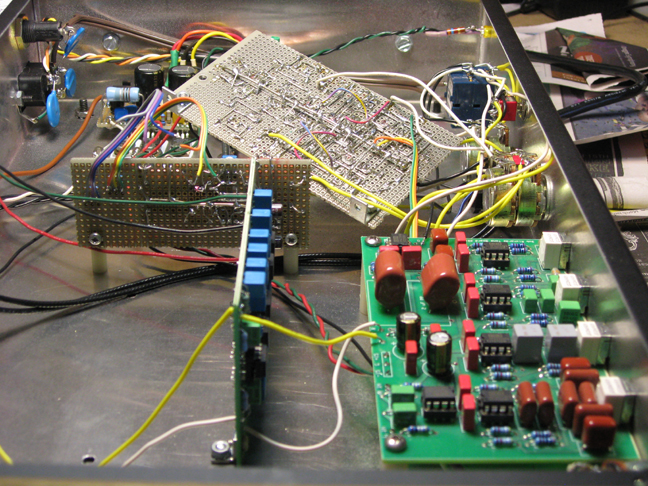
I was modifying the compressor board after doing some tests with tone bursts on the bench.
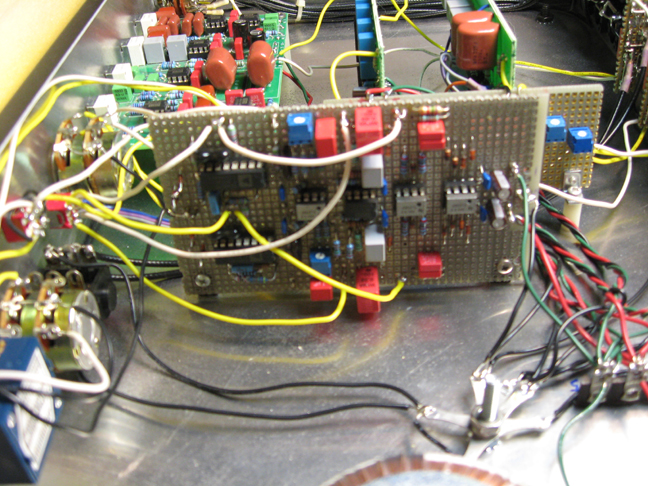
Here's the component side of the compressor circuit board.
I built and lived with a SWTPC stereo optical compressor back in college, and I liked how it made the music easier to listen to over time.
You never noticed that the conmpressor was on and doing anything, but the music was less irksome.
Getting a compressor right is actually fairly challenging. You have to choose attack and decay times, you might want to frequency contour the control voltage, and they can get even more complicated if you want.

I don't listen to a lot of Classical orchestral music, but when I do I like to have the violin section be on the left, so I included a Stero Reverse switch in case that comes out wrong. The compressor circuit has a bypass switch.
A last minute addition was the front panel input, and the front panel final output, so it's easy to connect up a portable music source, or to drive a portable digital recording device. As a musician, I will actually use those.

A Hammond aluminum chassis looks way better with the white oak end panels.
When you paint aluminum, you absolutely must steal wool the surface (or use fine sandpaper), wash it with dish soap and hot water, and use a primer paint that is specifically designed for aluminum. Or the paint will easily chip off over time.
There's a regular wideband out, and then the optional biamp outs with the active woofer EQ (a 10dB peak at 32HZ relative to above 150HZ, with a 2 pole drop off below that). About right for a typical 8 inch woofer in a closed box.
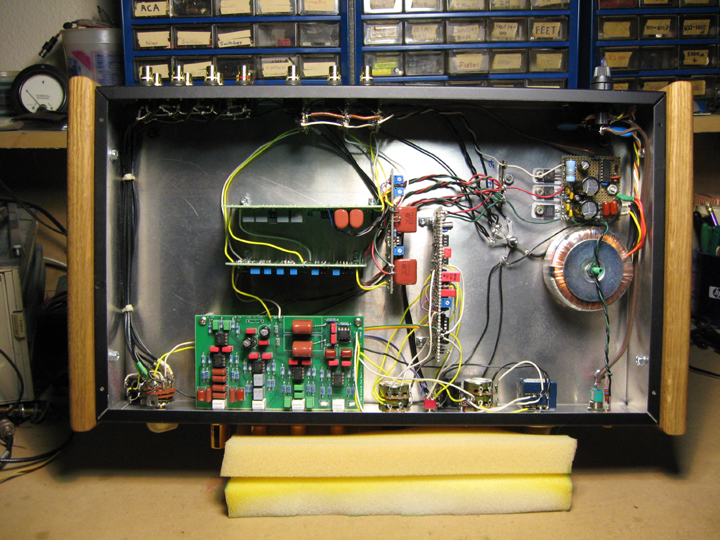
From above.
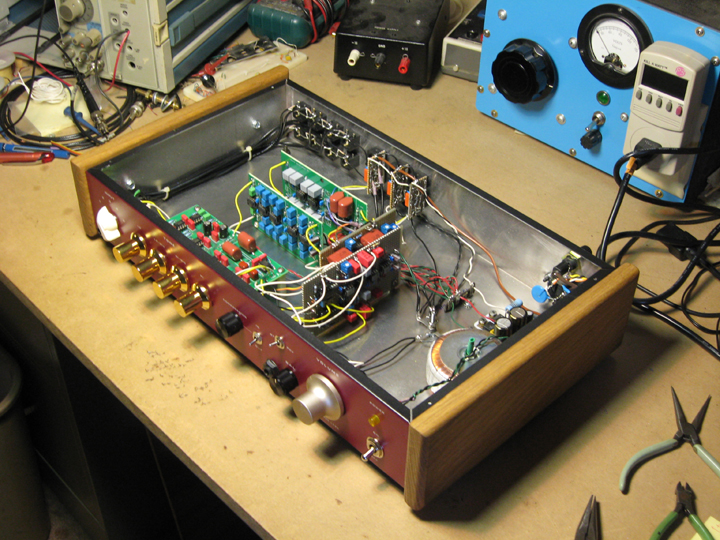
I spent a lot of time trying to find cool looking goood quality knobs, and ended up ordering the gold ones directly from some place I never heard of in Hong Kong. The other knobs came from a more local guitar parts store.
The price for the knobs seemed great until I added in the cost of shipping, which may have included a duty fee. Then the price was about normal.
Most preamps try to have all the knobs be similar. I actually like them being different. A given knob is easier to locate. You don't have to think as much; um, which knob is it again (?).
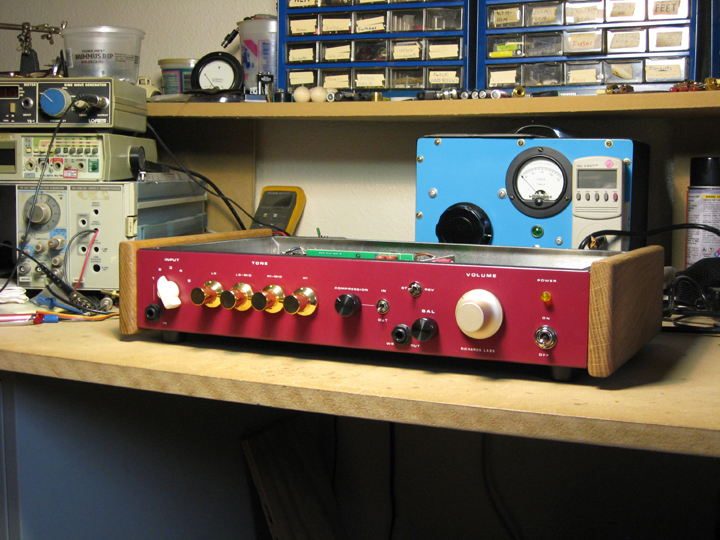
I'm very pleased with the result. My only criticism is that it doesn't have remote control. I'm not skilled in that area.
Since I'll be using it at my computer bench, a remote really isn't needed.
It will compliment the AR4XC speakers I built very nicely.
![]()